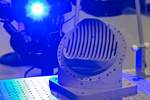Additive Manufacturing at NASA (Part 2): AM Radio #52
In this follow-up podcast episode on additive manufacturing at NASA, Dr. Tim Simpson joins us to discuss how the organization thinks about AM overall, and its role in advancing additive alongside and in service of commercial industry.
In this follow-up to episode #51 of AM Radio, Dr. Tim Simpson joins Stephanie Hendrixson and Pete Zelinski in the studio to talk more about how NASA is implementing and shaping additive manufacturing. As part of an intergovernmental personnel act (IPA) assignment, Dr. Simpson has spent the last two years deployed within NASA helping to advance additive use cases and connect AM users within the organization. In this episode, he shares insights from this work including NASA's collaborative relationship with commercial space; its role in studying AM fundamentals and providing testing resources; missions currently using the technology; and where additive will enable NASA to go next.
Listen to this podcast episode embedded above or, if you haven’t heard it yet, find Part 1 linked below:
This 3D printed heat exchanger (referenced in the episode) was made for the Mars Oxygen In-situ Resource Utilization Experiment (MOXIE), one of the instruments on the Perseverance Mars rover. Martian air is carried into channels within this part to be preheated before conversion into oxygen. Source: NASA/JPL-Caltech
Transcript
Coming soon
Related Content
-
AM Materials Consortium Selects Partners for LPBF Fabrication and Testing
The consortium is developing open LPBF parameter sets to streamline machine, material and process qualification, with the goal of expediting customers’ process development leading to serial production.
-
Velo3D Sapphire Printers Become First Metal 3D Printers to Achieve DOD Green-Level STIG Compliance
The certification allows Sapphire printers to be connected to the DOD’s Secret Internet Protocol Router Network (SIPRNet) and gives customers confidence that their metal 3D printers are hardened against potential cyberattacks and other vulnerabilities.
-
Valve Manufacturer Outlines Path to Qualification for Additive Manufactured Pressure Equipment
In this case study, Samson shares how manufacturers can design and produce pressure equipment using additive manufacturing that is compliant with the European Pressure Equipment Directive (PED).

.jpg;width=70;height=70;mode=crop)










